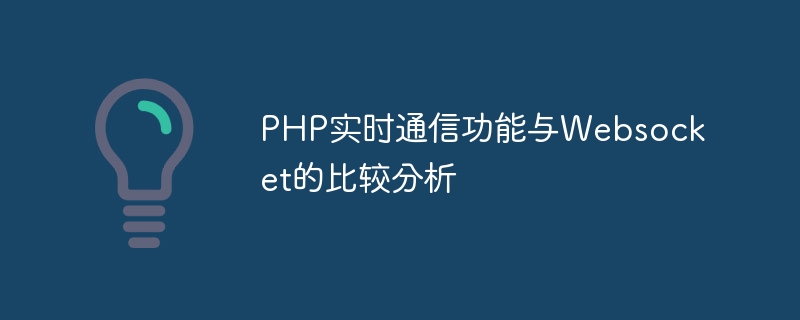

Comparative analysis of PHP real-time communication function and WebSocket
With the continuous development of the Internet, real-time communication function is becoming more and more important in websites and applications. The real-time communication function allows users to communicate and interact in scenarios with high real-time requirements, such as online chat, multiplayer games, instant messaging, etc. As a popular server-side programming language, PHP also provides a variety of methods to achieve real-time communication, among which Websocket is a commonly used technology. This article will conduct a comparative analysis of PHP real-time communication functions and Websocket, and give some code examples.
1. PHP real-time communication function
2. Websocket
Websocket is a full-duplex communication protocol. Its design goal is to establish a persistent connection between the client and the server to achieve two-way communication. Compared with the above-mentioned PHP real-time communication method, Websocket has the following advantages:
Some sample codes are given below to demonstrate how to use PHP to implement Websocket communication functions.
Server-side code example:
<?php
$server = new WebSocketServer("localhost", 8000);
//监听连接事件
$server->addListener("connect", function ($connection) {
echo "Client connected: " . $connection->getId() . "
";
});
//监听数据接收事件
$server->addListener("receive", function ($connection, $data) {
echo "Received from client: " . $data . "
";
//处理数据,可以将数据发送给其他客户端
});
//监听断开连接事件
$server->addListener("disconnect", function ($connection) {
echo "Client disconnected: " . $connection->getId() . "
";
});
//启动服务器
$server->start();
?>Client-side code example:
<!DOCTYPE html>
<html>
<head>
<title>Websocket Client</title>
<script>
//创建Websocket对象
var socket = new WebSocket("ws://localhost:8000");
//连接成功事件
socket.onopen = function(event) {
console.log("Connected to server");
};
//接收消息事件
socket.onmessage = function(event) {
console.log("Received from server: " + event.data);
};
//关闭连接事件
socket.onclose = function(event) {
console.log("Connection closed");
};
//向服务器发送消息
function sendMessage() {
var message = document.getElementById("message").value;
socket.send(message);
}
</script>
</head>
<body>
<input type="text" id="message" />
<button onclick="sendMessage()">Send</button>
</body>
</html>Through the above code examples, we can see that it is relatively simple to use PHP to implement Websocket communication functions. The server handles the client's request by creating a WebSocketServer object and listening for events such as connection, data reception, and disconnection. The client establishes a connection with the server by creating a WebSocket object and sends and receives messages.
To sum up, compared with Websocket, PHP real-time communication function has lower delay, lower network load and two-way communication characteristics. In applications that require real-time communication, choosing Websocket as the technical solution for real-time communication is a more appropriate choice.
The above is the detailed content of Comparative analysis of PHP real-time communication function and Websocket. For more information, please follow other related articles on the PHP Chinese website!